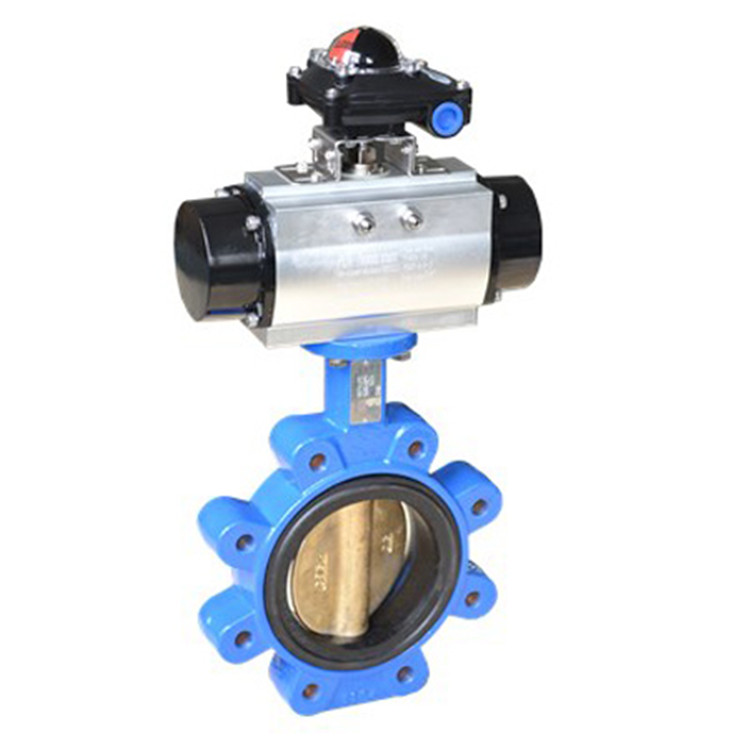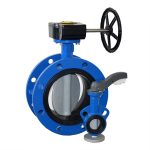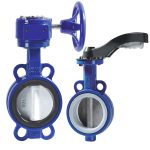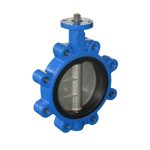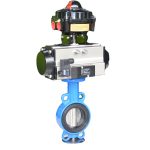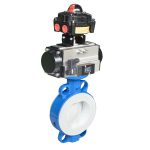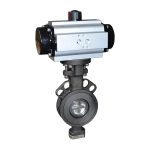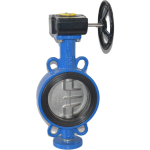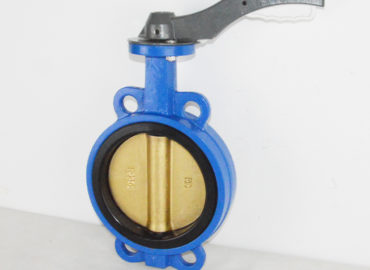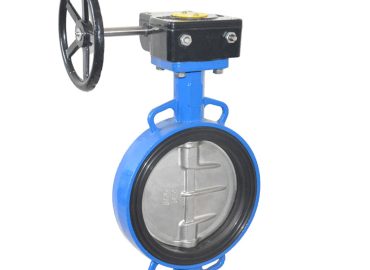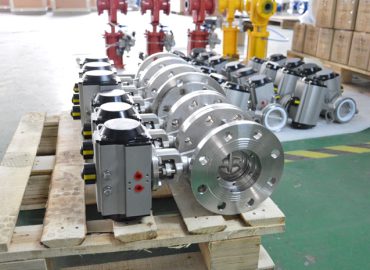In the world of industrial flow control, butterfly valve hold a pivotal role in regulating the flow of various types of fluids. Among these, lug and wafer butterfly valve are extensively used due to their unique design and functionality. However, beyond their structural design, an important yet often overlooked aspect is their metallurgical composition. The choice of materials used in manufacturing these valves significantly influences their performance, durability, and cost-efficiency. This blog post aims to delve deeper into the metallurgical aspects of lug and wafer butterfly valve, providing a comprehensive understanding of how material selection impacts these crucial components of industrial fluid control systems.
Introduction
Lug and wafer butterfly valves are critical components of industrial flow control systems, but their effectiveness and longevity are heavily influenced by the metallurgical aspects of their design. Butterfly valves, irrespective of their type, are typically composed of several key elements, namely the body, disc, stem, and seal. Each of these components can be made from a variety of materials, with the choice significantly impacting the valve’s performance, durability, and cost-efficiency. The valve body, for instance, is commonly constructed of ductile iron, carbon steel, or stainless steel. Ductile iron is often favored for its excellent strength-to-weight ratio and corrosion resistance, making it ideal for handling water, air, and some mild corrosive fluids. Carbon steel, on the other hand, is known for its superior strength and durability, which makes it suitable for high-pressure and high-temperature applications. Stainless steel is chosen for its exceptional corrosion resistance, especially in applications involving harsh or corrosive fluids. The disc, which is the primary flow-control element within the valve, is usually made from the same material as the body to ensure consistent performance and compatibility. The stem, which connects the disc to the actuator, may be made from stainless steel for its strength and corrosion resistance. Finally, the seal or seat, which ensures a tight closure when the valve is shut, can be made from a variety of materials including elastomers like EPDM or NBR, or PTFE for higher temperature applications. Each material has its own set of benefits and drawbacks, and the choice ultimately depends on the specific requirements of the application, such as the type of fluid being handled, the operating pressure and temperature, and the desired lifespan of the valve. By understanding these metallurgical aspects, engineers can make more informed decisions when selecting lug and wafer butterfly valves, ensuring optimal performance and longevity for their flow control systems.
Brief overview of butterfly valve – their uses, importance, and types.
Butterfly valve are a type of quarter-turn valve that control the flow of a fluid. Their name comes from the butterfly-like disc that rotates on a stem to open or close the flow path. Highly versatile, they are used across a myriad of industries including water and wastewater treatment, oil and gas, power generation, and even in home plumbing systems. The importance of butterfly valve lies in their efficiency and reliability in controlling fluid flow. They offer quick operation, excellent flow control, and lower pressure drops compared to other valve types. Furthermore, they are typically more compact and lighter, making them easier to install and less expensive. There are several types of butterfly valve, each designed for different applications and pressures. The most common types include concentric, double eccentric (or high-performance), and triple eccentric butterfly valve. Additionally, within these categories, two specific types – lug and wafer butterfly valve – are often used due to their unique design and functionality. Understanding the difference between these types, as well as their metallurgical aspects, can greatly assist in selecting the appropriate valve for a specific application.
Explanation of the focus of the blog post: metallurgical aspects of lug and wafer butterfly valve.
The primary focus of this blog post is to explore the metallurgical aspects of wafer and lug butterfly valve. While these valves are key components in numerous industrial applications, their performance and durability depend significantly on the choice of materials used in their construction. This post aims to delve into the specifics of the metals used in the body, disc, stem, and seal of these valves, shedding light on how different materials contribute to the overall functionality of the valve. We will also discuss the implications of these choices, including corrosion resistance, strength, and temperature tolerance, among others. By understanding the metallurgical aspects of these valves, one can make informed decisions regarding the most suitable valve for a specific application. This in-depth exploration can provide valuable insights for engineers, technicians, and anyone involved in the selection or maintenance of lug and wafer butterfly valve in industrial flow control systems.
Understanding Butterfly Valve
Butterfly valves are a crucial part of many industrial and domestic systems, controlling the flow of fluids in pipelines and other conduits. The name ‘butterfly’ comes from the disc in the center of the valve which rotates similarly to a butterfly’s wings flapping. The disc, attached to a rod or stem, rotates a quarter turn to open or close the valve, hence it is also classified as a quarter-turn valve. When the disc is parallel to the fluid flow, the valve is fully open, and when it’s perpendicular, the valve is closed. One of the key advantages of butterfly valves is their simplicity and efficiency. They are compact, easy to install, and require less material than other types of valves, making them relatively cost-effective. Moreover, they provide quick shutoff and can be used for both isolation and throttling applications. Butterfly valves come in several types, including concentric, double eccentric (high-performance), and triple eccentric, each with its unique design suited for different pressure ratings and applications. There are also two specific designs known as lug and wafer butterfly valves that are commonly used due to their unique features and benefits. Despite their simplicity, the performance and longevity of butterfly valves depend heavily on the choice of materials used in their construction, often referred to as their metallurgical aspects. These include the materials used for the body, disc, stem, and seal, which can range from various types of steel to different elastomers, each with its own strengths and weaknesses depending on the specific application. Understanding these aspects is essential for anyone involved in the selection, operation, or maintenance of butterfly valves.
Detailed explanation of what butterfly valves are.
Butterfly valves are a specific type of valve used to regulate and isolate the flow of a fluid in a system. They get their name from the butterfly-like disc that sits in the center of the pipe. This disc is attached to a stem which, when turned, causes the disc to rotate. The position of the disc determines the level of flow within the system. When the disc is turned such that it’s parallel to the flow of fluid, the valve is fully open, allowing for maximum flow. Conversely, when the disc is rotated to a position perpendicular to the flow, the valve is fully closed, halting the flow entirely. This simple yet effective mechanism allows for quick and efficient control of fluid flow. Butterfly valves are considered quarter-turn valves because they use a rotational motion of 90 degrees to fully open or close. They are popular in various industries due to their compact design, ease of operation, and cost-effectiveness. They can be made from various materials, including different types of metal and plastic, to suit a wide range of applications and operating conditions. It’s important to note that there are various types of butterfly valves, including concentric, double-eccentric, and triple-eccentric designs, each offering unique benefits and being suitable for different applications.
Discussion on the various types of butterfly valves with a focus on lug and wafer butterfly valve.
Butterfly valves are primarily categorized into two types: lug-style and wafer-style, each with its unique advantages and applications. Butterfly valves, in general, have a disc that rotates to allow or block the flow of fluid. In a concentric design, the most common type, both the turning axis and axial alignment of the disc are centered with the valve body. Lug butterfly valves, constructed from metals such as ductile iron or steel, feature threaded lugs on their flanges for bolt connections, which allows them to be installed or removed without disrupting the entire system. On the other hand, wafer butterfly valves serve as a low-cost solution for isolation and can be installed between two flanges using long bolts or studs. Wafer-style valves are the most common type of butterfly valve due to their cost-effectiveness and ease of installation. It’s important to note that there are also other types of butterfly valves, including flanged and welded, and they can be lined with different materials like rubber, plastic, or metal depending on the application requirements .

Metallurgy in Valve Manufacturing
Metallurgy plays a significant role in the manufacturing of valves, as it determines the strength, durability, and resistance to various environmental conditions of the final product. Various types of metals are used in valve manufacturing, including titanium, 904L, duplex, and super duplex, each offering unique properties suitable for different applications. For instance, WSV Valve offers custom-made solutions for metallurgy valve applications, utilizing these metals for manufacturing plug, ball, and flash drum control valves. Additionally, techniques such as Metal Additive Manufacturing (AM) have gained acceptance in the valve industry, facilitating automation and precision in the production process. The fabrication of valves also involves processes like forging, which shapes metal components through mechanical forces to achieve the desired design and functionality. Another important aspect of valve manufacturing is the production of valve seats and valve guides, often made through powder metallurgy. This process involves compacting metal powders into a desired shape and then heating it to a temperature below its melting point to create a solid object. Furthermore, in some applications, plastic diaphragm and ball valves are used due to their high temperature resistance and large flow rate, especially in hydrometallurgy. Lastly, MOGAS manufactures metal seated ball valves for autoclave Pox and HPAL systems, and slurry mining transport pipeline applications, indicating the wide range of uses for valves in different industries.
Explanation of the role of metallurgy in valve manufacturing.
Metallurgy is a crucial aspect of valve manufacturing as it significantly influences the functionality, durability, and performance of the valves. The choice of metal or alloy used in the construction of valves depends largely on the specific application and operating conditions. For instance, stainless steel, known for its corrosion resistance, is commonly used in environments where the valve is likely to come into contact with corrosive substances. Brass, on the other hand, is often chosen for its machinability and cost-effectiveness. More robust metals like carbon steel are employed in high-pressure and high-temperature applications due to their excellent strength and toughness. In addition to the choice of material, various metallurgical processes such as casting, forging, heat treatment, and welding are involved in valve manufacturing. Casting and forging shape the valve components, while heat treatment enhances the mechanical properties of these components. Welding is used to join different parts together. Therefore, understanding metallurgy is key to designing and producing valves that can withstand specific pressures, temperatures, and chemical environments while delivering optimal performance.
Overview of common metals used in the manufacture of valves and their properties.
Several types of metals are used in the manufacture of valves, each bringing unique properties that make them suitable for specific applications. Stainless steel is one of the most common materials used due to its excellent corrosion resistance and durability. It’s often utilized in environments with corrosive substances or where hygiene is a priority, such as food processing or pharmaceutical industries. Brass, another popular choice, is known for its good machinability, resistance to corrosion and wear, making it ideal for plumbing and gas control valves. Carbon steel, characterized by its high strength and toughness, is frequently used in high-pressure and high-temperature environments like power plants. Ductile iron is favored for its superior tensile strength and elasticity, commonly used for larger valves in water and sewage applications. Bronze, with its resistance to cavitation damage, is often used for pump and propeller systems. Lastly, titanium, while more expensive, offers exceptional resistance to extreme temperatures and corrosive environments, making it suitable for demanding applications such as those found in the chemical processing industry. Understanding these material properties helps valve manufacturers choose the right metal for each application, ensuring optimal valve performance and longevity.
Lug Butterfly Valve: Metallurgical Perspective
From a metallurgical perspective, lug butterfly valves are fascinating specimens. These types of valves are typically constructed from a variety of metals, each chosen for their specific properties to ensure optimal performance and durability. The body of the valve, which needs to withstand high pressures and possible corrosive environments, is often made from ductile iron, stainless steel, or carbon steel. Ductile iron is favored for its excellent strength, toughness, and wear resistance. Stainless steel offers superior corrosion resistance and is particularly suitable in environments where the valve might be exposed to harsh chemicals or high levels of humidity. Carbon steel, on the other hand, provides excellent strength and toughness, making it ideal for high-pressure applications. The disc, which controls the flow of fluid, is usually made from stainless steel or a coated version of it to prevent corrosion and ensure smooth operation. The stem, which connects the actuator and the disc, is often made from stainless steel for its strength and corrosion resistance. The seat, which provides a seal when the valve is closed, could be made from resilient materials like EPDM, Buna-N, or Viton, depending on the application. From casting or forging the valve components to heat treating them for enhanced mechanical properties, the role of metallurgy in the manufacturing of lug butterfly valves is indeed significant. It allows manufacturers to design and produce valves that are capable of operating efficiently and reliably under a wide range of conditions.
Detailed look at the lug butterfly valve design.
A lug butterfly valve is a sophisticated piece of engineering designed to control the flow of liquid or gas through a pipeline. It’s a quarter-turn valve, meaning it opens and closes with a 90-degree turn of its handle. The most distinctive feature of the lug butterfly valve design is the disc mounted on the stem inside the valve body. When the handle is turned, this disc rotates, either blocking the flow when in a perpendicular position or allowing it when aligned with the flow direction. The body of the lug butterfly valve is designed to fit between two pipe flanges, which makes it suitable for dead-end service or scenarios where one side of the valve needs to be disconnected without interrupting the flow on the other side. Moreover, lug butterfly valves are known for their simple construction and operation mechanism, offering reliable control and exceptional durability. They come in both wafer and lug styles, with the latter having lugs around the valve body to allow it to be installed into a system using two sets of bolts and no nuts. This design provides the advantage of not needing to be sandwiched between two flanges, making maintenance or replacement of these valves more convenient.
Examination of the metals/materials commonly used in its manufacture.
A closer examination of the metals and materials commonly used in the manufacture of lug butterfly valves reveals a focus on durability, strength, and resistance to corrosion. The body of the valve, which bears the brunt of the operating pressure, is often made from ductile iron, carbon steel, or stainless steel. Ductile iron is valued for its excellent strength and wear resistance, while carbon steel offers high strength and toughness – attributes that are particularly useful in high-pressure applications. Stainless steel, known for its superior corrosion resistance, is ideal for use in potentially corrosive environments or where hygiene is paramount. The disc, which functions as the flow control element, is typically made from stainless steel or a coated version of the material to prevent corrosion. The stem, linking the actuator and the disc, is also often made from stainless steel due to its strength and corrosion resistance. Finally, the seat, which forms a seal when the valve is closed, could be made from resilient materials such as EPDM (ethylene propylene diene monomer rubber), Buna-N (nitrile rubber), or Viton (fluoropolymer elastomer), depending on the specific application requirements. These materials are chosen for their ability to withstand various temperatures, pressures, and chemical environments, ensuring the longevity and reliable performance of the valve.
Discussion of why these specific materials are chosen, considering factors like corrosion resistance, strength, cost, etc.
The selection of specific materials for the construction of lug butterfly valves is a careful process that considers several crucial factors. Corrosion resistance is one of the primary considerations. Materials like stainless steel are chosen for parts such as the body, disc, and stem due to their excellent resistance to corrosion, which ensures the longevity and reliability of the valve in various environments, including those involving harsh chemicals or high humidity levels. Strength is another essential factor. Ductile iron and carbon steel are often used because of their exceptional strength and toughness, which allow the valve to withstand high pressures and stress without deforming or failing. Cost also plays a significant role in material selection. While materials like stainless steel offer superior properties, they can be more expensive. Therefore, manufacturers may opt for less costly materials like ductile iron or carbon steel, especially in applications where the added benefits of stainless steel are not necessary. Finally, the material used for the seat, such as EPDM, Buna-N, or Viton, is selected based on its ability to provide a reliable seal at various temperatures and pressures, as well as its compatibility with the fluid being controlled. All these considerations ensure that the chosen materials contribute to the overall performance, durability, and cost-effectiveness of the lug butterfly valve.
Wafer Butterfly Valve: Metallurgical Perspective
From a metallurgical perspective, wafer butterfly valves are interesting because they incorporate a range of materials chosen for their specific properties to ensure the valve performs optimally under a variety of conditions. The body of the valve, which is exposed to the most pressure, is typically made from robust and durable metals like ductile iron, carbon steel, or stainless steel. Ductile iron, a type of cast iron known for its strength and toughness, is often used because it can withstand high pressures and impacts without fracturing. Carbon steel is another popular choice due to its high tensile strength and resilience – qualities that are essential in high-pressure applications. Stainless steel is preferred when the valve is expected to operate in corrosive environments because it offers exceptional resistance to corrosion and rust.
The disc, which acts as the flow control element, is usually made from stainless steel or a coated version of the same to enhance corrosion resistance. In some cases, other materials like bronze or even plastic might be used, especially if the valve has to handle certain corrosive fluids.
The stem, which connects the actuator to the disk, is also typically made from stainless steel, chosen for its strength and corrosion resistance. In certain corrosive environments, a higher grade of stainless steel or even a nickel alloy might be used for the stem.
Lastly, the seat of the valve, which forms the seal when the valve is closed, is usually made from resilient materials such as EPDM, Buna-N, or Viton. These elastomers are selected based on their resistance to temperature changes, pressure levels, and chemical compatibility with the fluid being controlled.
In summary, the choice of materials for wafer butterfly valves is a careful balance between cost, performance, and durability. Various metals and materials are chosen based on their mechanical properties, corrosion resistance, and cost-effectiveness to ensure the valve will perform reliably under its intended operating conditions.
Detailed look at the wafer butterfly valve design.
A detailed look at the wafer butterfly valve design reveals a highly economical yet efficient mechanism for controlling fluid flow. The fundamental design of a wafer butterfly valve involves a lightweight disc that rotates around a central axis, enabling precise fluid flow control. This disc is sandwiched between two flanges, with none of the bolts on the flange threading directly into the valve body itself. This design allows for easy installation and removal, contributing to its cost-effectiveness. The thin profile of the disc, along with the compact design of the valve, makes it an ideal choice for systems where space is limited. Moreover, the wafer-style body uses bolt holes that run through the body of the valve for connection to the pipes, making it more economical than other designs. The design of the valve conforms to API 609 Class A, with mounting pads conforming to ISO 5211, and ends that conform to ASME B16.1 and B16.5. These standards ensure the valve’s robustness, reliability, and compatibility with various systems. Overall, the wafer butterfly valve design combines economy, efficiency, and versatility, making it a popular choice in numerous applications (Sources:POV Butterfly Valve).
Examination of the metals/materials commonly used in its manufacture.
Examining the metals and materials commonly used in the manufacture of wafer butterfly valves reveals a careful selection based on durability, strength, and resistance to various environmental factors. For the valve body, metals such as ductile iron, carbon steel, or stainless steel are often used. Ductile iron is favored for its excellent strength and impact resilience, while carbon steel offers high tensile strength, making it ideal for high-pressure applications. Stainless steel, renowned for its superior corrosion resistance, is the material of choice when the valve is expected to operate in corrosive environments. The disc of the valve, which regulates the flow of fluid, is typically made from stainless steel, although coated versions may be used to enhance corrosion resistance. In certain scenarios, other materials like bronze or even plastic might be employed, particularly if the valve has to handle specific corrosive fluids. The stem, connecting the actuator to the disk, is also usually made from stainless steel due to its strength and corrosion resistance. For more corrosive environments, higher-grade stainless steel or even a nickel alloy might be used. Finally, the seat of the valve, forming the seal when the valve is closed, is generally made from resilient materials like EPDM, Buna-N, or Viton, chosen for their resistance to temperature changes, pressure levels, and compatibility with the controlled fluid. The synthesis of these materials results in a valve that is durable, efficient, and capable of performing under various conditions.
Discussion of why these specific materials are chosen, considering factors like corrosion resistance, strength, cost, etc.
The specific materials chosen for the manufacture of wafer butterfly valves are determined by several factors, including corrosion resistance, strength, cost, and the operational environment. Ductile iron, carbon steel, and stainless steel are typically used for the valve body due to their exceptional strength and durability, which are necessary to withstand the high pressure that these components are exposed to. Among these, stainless steel is particularly favored in corrosive environments for its outstanding corrosion resistance. Similarly, the disc and stem are also made from stainless steel or sometimes higher-grade alloys, considering the need for both strength (to handle the mechanical stress of opening and closing the valve) and corrosion resistance (since these parts are directly exposed to the fluid).
The choice of material for the seat, such as EPDM, Buna-N, or Viton, is influenced by their resilience and compatibility with the fluid being controlled. These materials can resist temperature changes and pressure levels, ensuring a reliable seal when the valve is closed.
Cost is another significant factor in material selection. For instance, while metals like titanium or high-grade alloys might offer superior performance in certain aspects, they are often prohibitively expensive for most applications. Therefore, materials like ductile iron, carbon steel, and standard grades of stainless steel, which offer a good balance of performance and cost, are commonly used.
In summary, the choice of materials for wafer butterfly valves is a careful balance between various factors, including corrosion resistance, mechanical strength, compatibility with the controlled fluid, and cost. This ensures that the valve will perform reliably under its intended operating conditions while remaining economically viable.
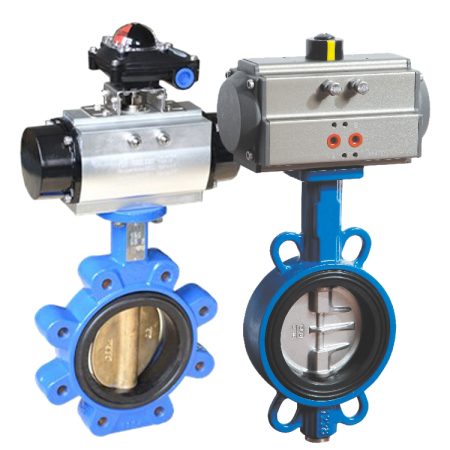
Comparing Lug and Wafer Butterfly Valve from a Metallurgical Standpoint
From a metallurgical standpoint, both lug and wafer butterfly valves share many similarities given their shared purpose in controlling fluid flow. However, there are differences that can impact their suitability for different applications. Both types of valves typically use robust metals like ductile iron, carbon steel, or stainless steel for the body, disc, and stem. These materials offer excellent strength and durability, with stainless steel additionally providing superior corrosion resistance. This makes it ideal for use in environments where the valve is exposed to corrosive fluids or harsh conditions.
However, the design differences between lug and wafer butterfly valves can lead to variations in the specific grades or types of these metals used. Lug butterfly valves, designed for end-of-line service and capable of handling higher pressure loads, might require stronger, more resilient materials or thicker constructions compared to wafer butterfly valves. This could necessitate the use of higher grade steels or alloys, which offer enhanced mechanical properties.
Furthermore, lug butterfly valves, due to their ability to be disassembled from a piping system without interrupting the fluid flow, may demand more robust materials for the lugs themselves to ensure they can withstand the mechanical stresses involved. On the other hand, wafer butterfly valves, being sandwiched between two flanges, may not require such heavy-duty materials, potentially resulting in cost savings.
In terms of the seat material, which forms the seal when the valve is closed, both lug and wafer butterfly valve often use resilient materials like EPDM, Buna-N, or Viton. The choice depends on factors like temperature resistance, pressure levels, and compatibility with the controlled fluid.
In summary, while both lug and wafer butterfly valve use similar categories of materials, the specific choice and construction can vary depending on the design and intended application of the valve. This ensures that each type of valve can perform optimally under its expected operating conditions, providing reliable control of fluid flow.
Comparative analysis of the materials used in lug and wafer butterfly valve.
When comparing the materials used in the construction of lug and wafer butterfly valve, it is evident that both types utilize similar materials due to their shared function of controlling fluid flow. The body of both valve types is typically made of robust metals, such as ductile iron, carbon steel, or stainless steel. These metals are chosen for their excellent strength and durability, with stainless steel offering additional corrosion resistance, making it ideal for use in environments where the valve might be exposed to corrosive fluids.
However, there may be variations in the specific grades or types of these metals used based on the design and application of each valve type. Lug butterfly valves, which are designed for dead-end service and can handle higher pressure loads, might require stronger or more resilient materials compared to wafer butterfly valves. This could mean using higher-grade steels or alloys that offer enhanced mechanical properties. Lug butterfly valves may also require more robust materials for the lugs themselves to ensure they can withstand the mechanical stresses involved in disassembling from a piping system without interrupting fluid flow.
On the other hand, wafer butterfly valves, which are sandwiched between two pipe flanges, may not require such heavy-duty materials, leading to potential cost savings. The seat material in both lug and wafer butterfly valves often consists of resilient materials like EPDM, Buna-N, or Viton, chosen based on factors such as temperature resistance, pressure levels, and compatibility with the controlled fluid.
In summary, while lug and wafer butterfly valve employ similar categories of materials, the specific choice and application of these materials can vary based on the design and intended use of each valve type. This ensures optimal performance under expected operating conditions and reliable control of fluid flow.
Discussion on how the choice of material impacts the performance, durability, and cost-effectiveness of each type.
The choice of material significantly impacts the performance, durability, and cost-effectiveness of both lug and wafer butterfly valve. Performance-wise, the materials need to withstand the pressures and temperatures they will be exposed to during operation. For instance, stainless steel’s resistance to corrosion makes it an excellent choice for applications involving corrosive fluids, contributing to the valve’s overall performance.
Durability is another key factor influenced by the material selection. Materials like ductile iron and carbon steel are known for their strength and durability, making them ideal for handling the mechanical stress valves are subjected to. The use of these durable materials can extend the valve’s lifespan, reducing the need for frequent replacement or maintenance.
Cost-effectiveness, on the other hand, is a balance between performance, durability, and the material’s price. While high-grade alloys might offer superior performance and durability, they are often more expensive, which could make the valve cost-prohibitive for some applications. Therefore, materials like ductile iron, carbon steel, and standard grades of stainless steel are widely used as they offer a good balance of performance, durability, and cost.
In conclusion, the choice of material plays a crucial role in determining a valve’s performance, durability, and cost-effectiveness. It is a delicate balance that manufacturers must strike to ensure the valve performs optimally under its intended operating conditions while remaining economically viable.
The Impact of Metallurgy on Valve Performance and Lifespan
Metallurgy plays a crucial role in the performance and lifespan of valves, directly impacting their functionality, durability, and efficiency. The choice of material can significantly influence a valve’s ability to withstand varying pressures, temperatures, and corrosive environments. For instance, stainless steel is often used in valves due to its excellent resistance to corrosion and ability to endure high temperatures, making it suitable for applications involving harsh or corrosive fluids. This leads to enhanced performance and a longer lifespan for the valve.
On the other hand, ductile iron and carbon steel are known for their exceptional strength and durability, making them ideal for handling the mechanical stress that valves are subjected to, especially in high-pressure applications. This contributes to the valve’s robustness and longevity, reducing the need for frequent maintenance or replacement.
Furthermore, the use of higher-grade alloys or specially treated materials can offer superior mechanical properties, such as increased hardness or improved resistance to wear. These materials can further enhance the valve’s performance, particularly in challenging operating conditions, and extend its service life.
However, it’s important to note that the choice of material must be tailored to the specific application of the valve. Using a material that is over-specified for an application can lead to unnecessary costs, while under-specifying can result in premature failure and reduced performance.
In conclusion, the impact of metallurgy on valve performance and lifespan is significant. A carefully considered choice of material, based on the specific requirements of the valve’s intended application, can ensure optimal performance and maximum lifespan, leading to improved efficiency and cost-effectiveness over the valve’s operational life.
Explanation of how the metallurgical aspects influence the performance, durability, and lifespan of butterfly valve.
The metallurgical aspects of butterfly valves significantly influence their performance, durability, and lifespan. The choice of metal used can affect the valve’s ability to withstand varying pressures and temperatures, as well as its resistance to corrosion and wear. For instance, stainless steel is often used in butterfly valves due to its excellent corrosion resistance, making it suitable for applications involving corrosive fluids. This enhances the valve’s performance and extends its lifespan by preventing premature degradation caused by corrosion.
On the other hand, materials like ductile iron and carbon steel are known for their robustness and durability, making them capable of enduring the mechanical stresses that valves are subjected to. This contributes to the valve’s longevity and reduces the frequency of maintenance or replacement, thereby enhancing cost-effectiveness.
Furthermore, the use of high-grade alloys or specially treated materials can provide superior mechanical properties, such as increased hardness or improved wear resistance. These materials can further improve the valve’s performance, particularly in challenging operating conditions, and extend its service life.
However, it is crucial to match the choice of material with the specific application of the valve. Over-specifying the material can lead to unnecessary costs, while under-specifying can result in premature failure and reduced performance.
In conclusion, the metallurgical aspects of butterfly valves play a significant role in determining their performance, durability, and lifespan. A carefully considered choice of material, based on the specific requirements of the valve’s intended application, can ensure optimal performance and maximum lifespan, leading to improved efficiency and cost-effectiveness over the valve’s operational life.
Discussion on the importance of material selection in butterfly valve design and manufacturing.
Material selection is a critical aspect of butterfly valve design and manufacturing, as it directly influences the valve’s performance, durability, and lifespan. The chosen material must withstand the operating conditions such as pressure, temperature, and the nature of the fluid passing through the valve. For instance, stainless steel is often used for its excellent corrosion resistance, making it suitable for applications involving corrosive fluids. This enhances the valve’s performance and longevity by preventing premature wear and tear caused by corrosion.
On the other hand, materials like ductile iron and carbon steel offer great strength and durability, making them ideal for handling high-pressure applications. Their use can extend the valve’s lifespan, reducing the need for frequent maintenance or replacement, and enhancing cost-effectiveness.
Moreover, the use of high-grade alloys or specially treated materials can provide superior mechanical properties, such as increased hardness or improved wear resistance. These materials can further improve the valve’s performance, particularly in challenging operating conditions, and extend its service life.
However, while material selection is crucial, it must be done considering the specific application of the valve. Over-specifying the material can lead to unnecessary costs, while under-specifying can result in premature failure and reduced performance. Therefore, a balanced choice of material, based on the specific requirements of the valve’s intended application, can ensure optimal performance and maximum lifespan, leading to improved efficiency and cost-effectiveness over the valve’s operational life.
Recent Advances in Metallurgy for Butterfly Valve Manufacturing
In recent years, there have been significant advancements in the field of metallurgy that have greatly influenced butterfly valve manufacturing. Innovations in butterfly valve technology now enable higher pressure and temperature handling, tighter shutoffs, and enhanced sustainability, as reported by Joanne Lunsford on Emerson Automation Experts and Valmet’s documentation on next-generation Neldisc and Wafer-Sphere butterfly valves. Furthermore, manufacturers are increasingly utilizing advancements in coatings for the valve bodies and discs to meet the evolving demands of various industries, as highlighted by PI Process Instrumentation. These new coatings not only improve the performance of the valves but also extend their lifespan by offering superior resistance to wear and corrosion.
Moreover, the range of materials used in butterfly valve manufacturing has expanded beyond traditional carbon steel and stainless steel to include nickel alloys, titanium alloys, and nickel aluminum bronze. These materials offer unique advantages such as improved strength, enhanced corrosion resistance, and better heat resistance, making them suitable for various applications, as discussed on Process Industry Forum.
In addition, manufacturers like Henan Yuda Valve Manufacturing Co., Ltd and WAM Group have introduced new designs and functionalities in their butterfly valves, characterized by reduced installation height and weight, improved plant design, assembly, and optimized delivery times. These innovations not only enhance the performance and reliability of the valves but also contribute to increased efficiency and cost-effectiveness in industrial production processes.
Overall, these advancements in metallurgy are revolutionizing butterfly valve manufacturing, leading to the creation of more durable, efficient, and versatile valves that can cater to a wider range of applications and operating conditions.
Overview of recent advancements in metallurgical science that have implications for butterfly valve manufacturing.
Metallurgical advancements have had a significant impact on butterfly valve manufacturing, paving the way for improved performance, sustainability, and efficiency. Recently, innovations such as the development of new butterfly valve technologies have enabled these valves to handle higher pressures and temperatures and achieve tighter shutoffs, as reported by Joanne Lunsford on Emerson Automation Experts.
Moreover, manufacturers are increasingly utilizing advanced materials and coatings to meet the ever-evolving demands of various industries. For example, a study published on MDPI introduced a triple offset butterfly valve with a new type of seal created by alternately laminating stainless steel and graphite, which significantly improves valve performance.
Another notable advancement is the launch of the next-generation Nel disc and Wafer-Sphere butterfly valves, engineered with sustainability in mind. These valves, as featured on Valmet, showcase a compact design that reduces material usage, thereby enhancing sustainability and cost-effectiveness.
Nelse has also made strides by implementing a modular design for its butterfly valve range, combining metal- and soft-seated types, as detailed on Valve World. This design offers superior process performance and flexibility, allowing for customization based on specific application requirements.
Overall, these developments in metallurgical science are revolutionizing butterfly valve manufacturing, leading to the creation of more efficient, durable, and versatile valves that cater to a wider range of applications and operating conditions.
Discussion on how these advancements can potentially improve the performance and longevity of butterfly valve.
The recent advancements in metallurgy have the potential to significantly enhance the performance and longevity of butterfly valves. New materials like nickel alloys, titanium alloys, and nickel aluminum bronze are being used due to their superior strength, corrosion resistance, and heat resistance. These characteristics enable the valves to withstand harsher operating conditions, thereby improving their performance and extending their lifespan.
Innovations in coatings technology also play a crucial role. Advanced coatings provide enhanced protection against wear and corrosion, further boosting valve durability. For instance, the use of a specialized coating can reduce friction between the disc and the seat of the valve, leading to smoother operation and reduced wear and tear.
Furthermore, the development of new butterfly valve technologies enables these valves to handle higher pressures and temperatures. This not only enhances their performance but also allows them to be used in a wider range of applications.
Lastly, the move towards more sustainable designs, such as the next-generation Nel disc and Wafer-Sphere butterfly valves, reduces material usage. This not only makes the valves more environmentally friendly but also improves their longevity by focusing on quality over quantity.
In essence, these advancements are paving the way for the creation of butterfly valves that are more efficient, durable, and versatile, capable of meeting the ever-evolving demands of various industries.
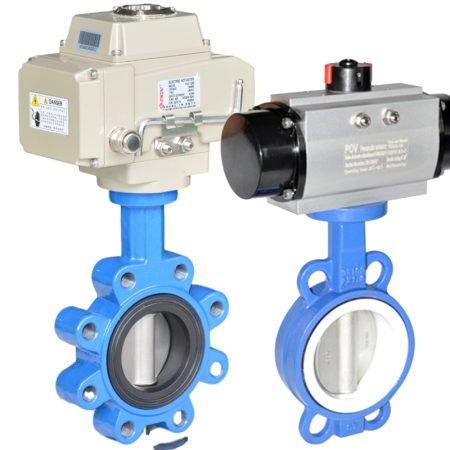
Conclusion
In conclusion, the exploration of metallurgical advancements in the manufacturing of lug and wafer butterfly valve has shed light on a fascinating intersection of science and industry. The developments in materials science have introduced new alloys and coatings that have significantly enhanced the performance, durability, and versatility of these valves.
From managing higher pressures and temperatures to providing tighter shutoffs, these advancements have allowed butterfly valves to meet the increasingly complex demands of various industries. The introduction of nickel alloys, titanium alloys, and nickel aluminium bronze has broadened the scope of applications for these valves, thanks to their superior strength, corrosion resistance, and heat resistance.
Moreover, the advent of advanced coatings has revolutionized the protection of these valves against wear and corrosion, thereby extending their lifespan. These coatings not only improve the performance of the valves but also contribute to their sustainability by reducing the need for frequent replacements.
The innovations in valve designs, such as the next-generation Nel disc and Wafer-Sphere butterfly valves, have also been noteworthy. With a focus on sustainability, these designs reduce material usage without compromising on performance, leading to more efficient and cost-effective solutions.
Finally, it’s important to note that these advancements are not an endpoint but rather a stepping stone towards further innovation. As the field of metallurgy continues to evolve, so too will the capabilities of lug and wafer butterfly valve. This ongoing evolution promises exciting opportunities for industries that rely on these critical components. As we look to the future, the role of metallurgy in marine butterfly valve manufacturing will undoubtedly continue to grow, driving progress and innovation across multiple sectors.
Recap of key points discussed in the blog post.
In the blog post, we delved into the impact of recent advancements in metallurgical science on the manufacturing of lug and wafer butterfly valve. We highlighted how new materials like nickel alloys, titanium alloys, and nickel aluminium bronze have improved the performance and longevity of these valves due to their superior strength, corrosion resistance, and heat resistance. We also discussed the role of advanced coatings in enhancing valve durability by providing additional protection against wear and corrosion.
Furthermore, we explored how these advancements have enabled butterfly valves to handle higher pressures and temperatures, thereby expanding their range of applications. We also touched upon the development of more sustainable valve designs, such as the next-generation Neldisc and Wafer-Sphere butterfly valves, which have reduced material usage while maintaining high performance and efficiency. Finally, we emphasized that these advancements are just the beginning, with further innovation expected as the field of metallurgy continues to evolve.
Final thoughts on the importance of understanding the metallurgical aspects when choosing between lug and wafer butterfly valve.
In conclusion, understanding the metallurgical aspects of lug and wafer butterfly valve is crucial when making a choice between the two. The materials used and their properties can significantly influence the valve’s performance, durability, and suitability for specific applications. For instance, valves made from alloys like nickel or titanium offer superior strength, corrosion resistance, and heat tolerance, making them ideal for demanding environments. Similarly, advanced coatings can enhance the life span of these valves by reducing wear and tear. Moreover, sustainable designs like the next-generation Neldisc and Wafer-Sphere butterfly valves not only perform efficiently but also contribute towards environmental sustainability. Therefore, a thorough understanding of these metallurgical aspects can guide you in selecting the most suitable butterfly valve that meets your specific needs and ensures long-term reliability.


